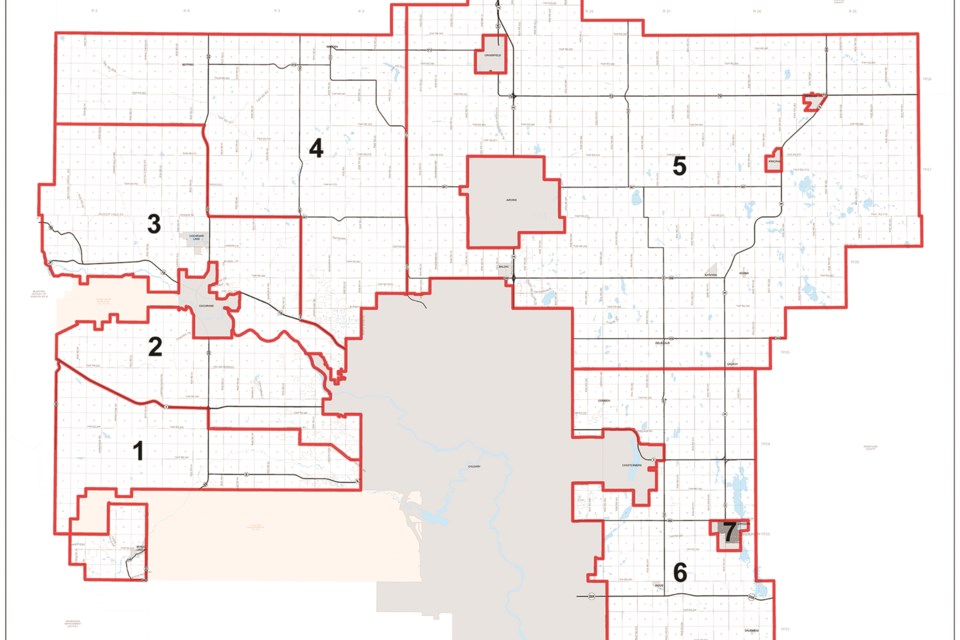With a municipal election less than a year away, Rocky View County (RVC) council approved a new bylaw that will redraw electoral divisions and reduce the number of councillors from nine to seven.
Council voted unanimously to adopt the Electoral Boundaries and Council Composition Bylaw at a regular meeting Oct 27. The bylaw will officially come into effect for the October 2021 municipal election.
"We had an external, independent review, including public input," Reeve Daniel Henn said. "Councillors voted unanimously for the division boundaries that came out of that process. Every one of our divisions will change for the next election, and there are political implications to that. But we did the right thing for the residents of RVC.”
Under the new bylaw, there will be seven electoral divisions in the county, compared to the nine current divisions, meaning the total number of councillors will decrease by two.
The bylaw also changes the title of RVC’s Chief Elected Official and Deputy Chief Elected Official. The title of “reeve” will be changed to “mayor,” and the “deputy reeve” will become the “deputy mayor.” These two positions will each be filled by a councillor, who will be appointed by their peers.
According to Brian Conger, project manager with ISL Engineering – the firm retained to conduct an independent review of RVC’s electoral boundaries and governance structure – the new divisions are meant to address changes to RVC’s population distribution since the last time electoral divisions were adopted.
“There has been an on-going discussion since the last time that the boundary review was done in 2000,” Conger said. “We have seen an increase in population and there has been concerns about equity when we look at the population distribution in the divisions.”
According to council’s agenda package, the optimum population of each division should be within 25 per cent of the population average, which is determined by dividing the County’s total population by the number of divisions. Based on 2018 census data, four divisions do not meet the optimum population requirement, deviating significantly from the average population of 4,523.
Conger said reducing the number of electoral divisions to seven balances the composition of each division while providing a share of future growth and stagnation.
Under the new bylaw, Division 1 will now include Bragg Creek, all development south of the Elbow River and a portion of the Springbank Area Structure Plan (ASP) south of Springbank Road. Division 2 contains the Harmony ASP and a portion of the Springbank ASP north of Springbank Road.
Division 3 contains the hamlet of Cochrane Lake and the Cochrane North ASP, the Glenbow Ranch ASP, and portions of the Bearspaw ASP west of Lochend Road and south of Highway 1A. Division 4 contains the hamlets of Bottrel and Madden, along with a portion of the Bearspaw ASP east of Lochend Road, following a current division boundary line.
Division 5 – geographically, the largest division – contains everything east of Highway 772 and Range Road 21 and north of Township Road 252 including Balzac, Kathryn, Keoma, Delacour, Dalroy and most of northeast RVC. Division 6 contains the area south of Township Road 252 – including Conrich, Indus and Dalemead – except Langdon, which stands alone as Division 7.
Conger said it took ISL ten months to create the divisions that were adopted. In that time, the firm conducted a best practices review of electoral boundary and governance models in Alberta’s municipal districts and specialized municipalities. ISL also conducted a population analysis to determine the current demographic context in RVC, along with a population projection to determine anticipated demographic change in the County. Feedback from the public was also gathered.
According to the agenda report, the boundary change could save the county approximately $864,000 over the first four years by eliminating two council positions. One councillor position costs the County an estimated $108,000 per year.
Coun. Kevin Hanson praised the hard work done that produced the new divisions.
“The fact that we actually get closer to population parity as time expires, I think was really hammered home today,” Hanson said.
Coun. Samanntha Wright also praised the work done by ISL and administration.
“I know it wasn’t easy,” she said. “It was nice to see that at the end of the day it was a decision the consultants made. It’s good to see that council is respecting that decision.”
Jordan Stricker, AirdrieToday.com
Follow me on Twitter @Jay_Strickz





